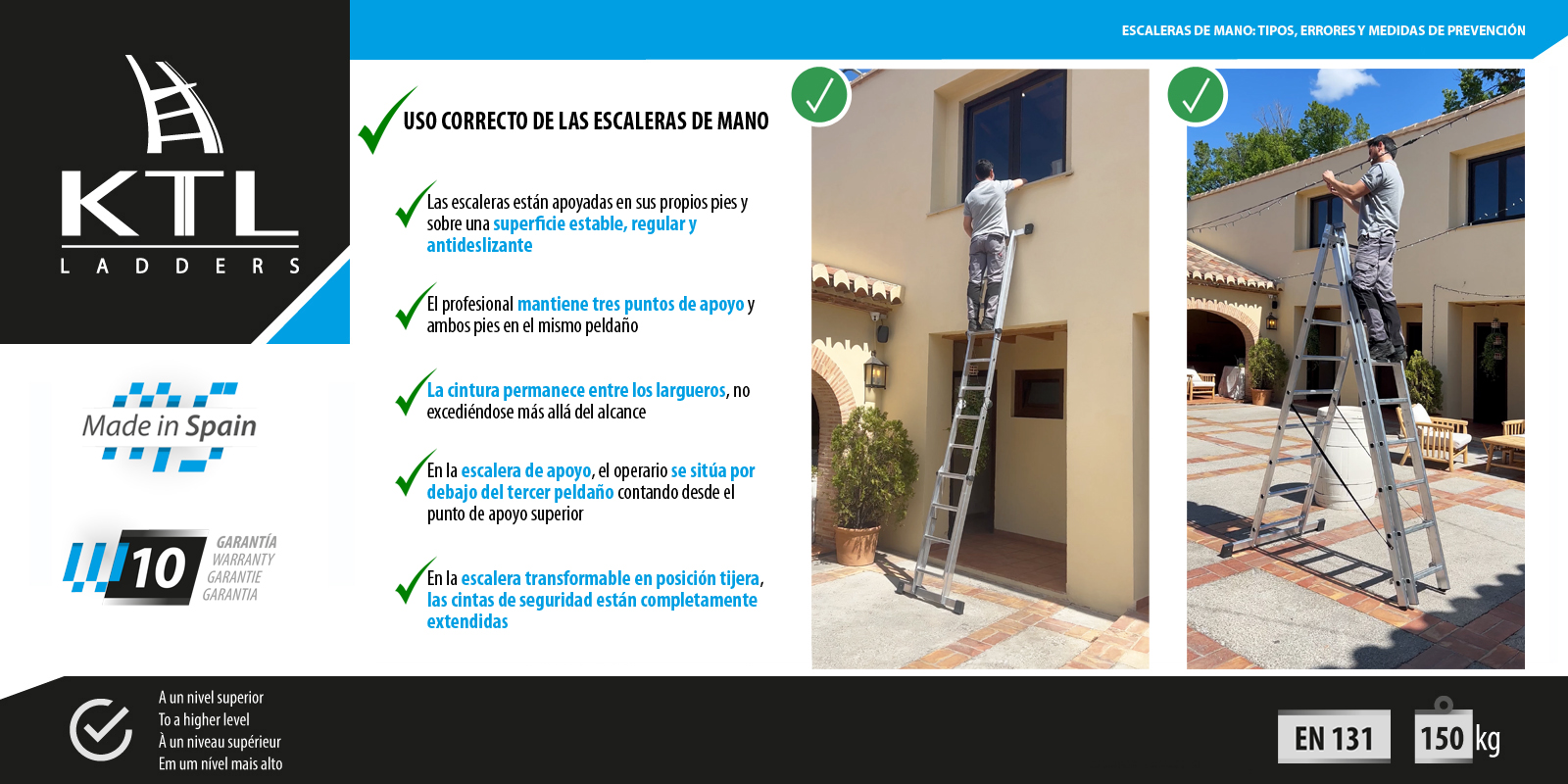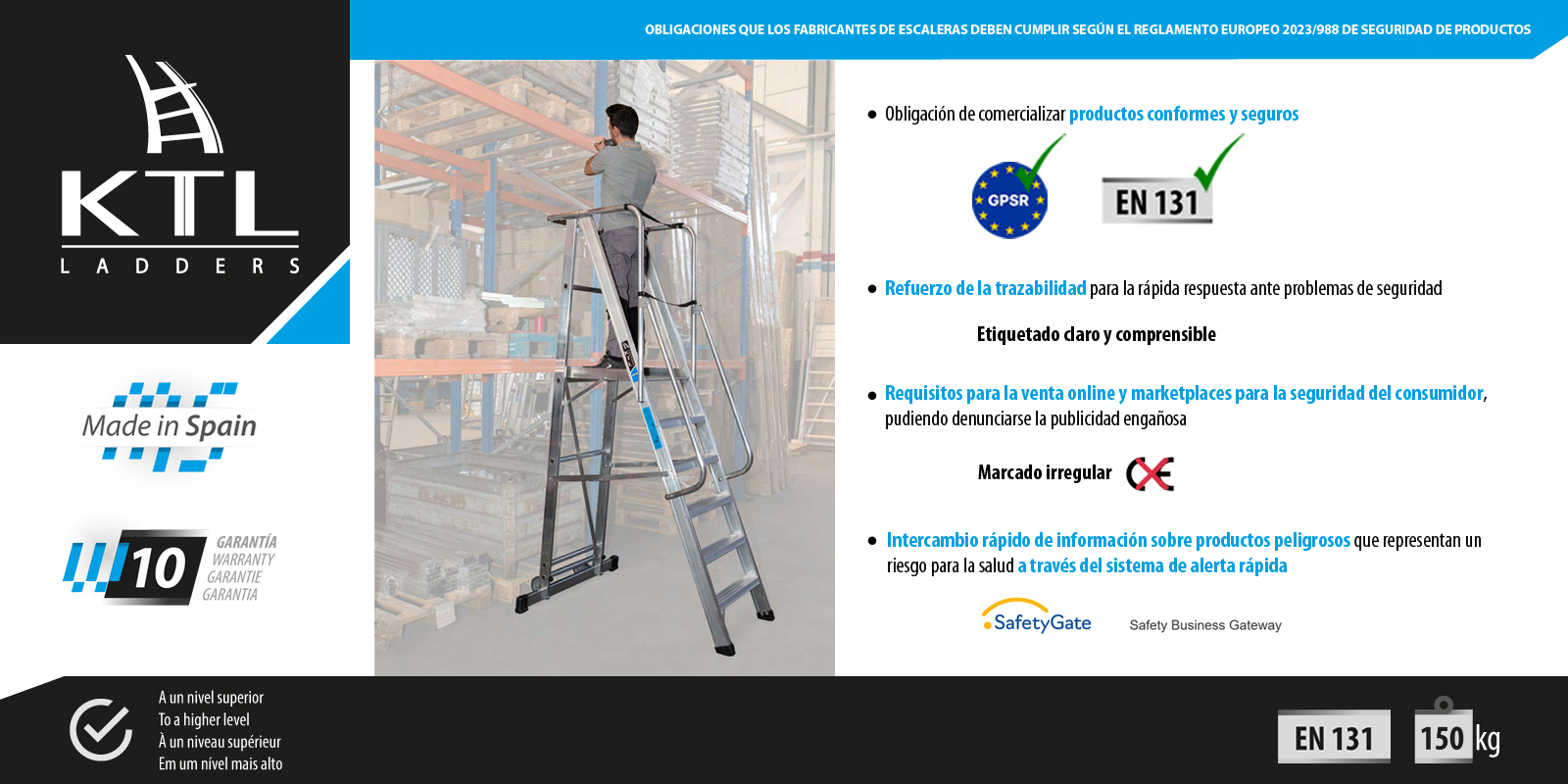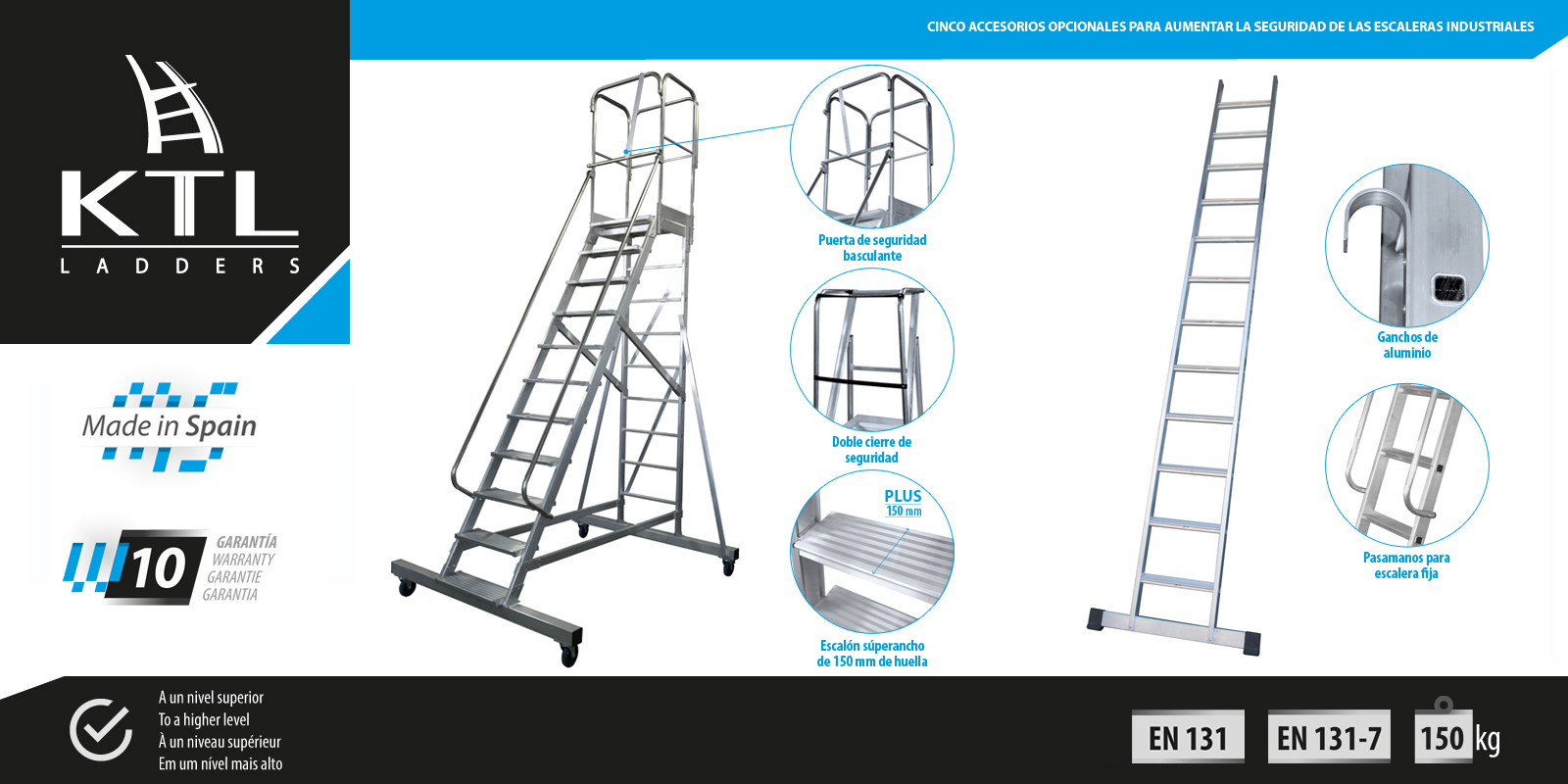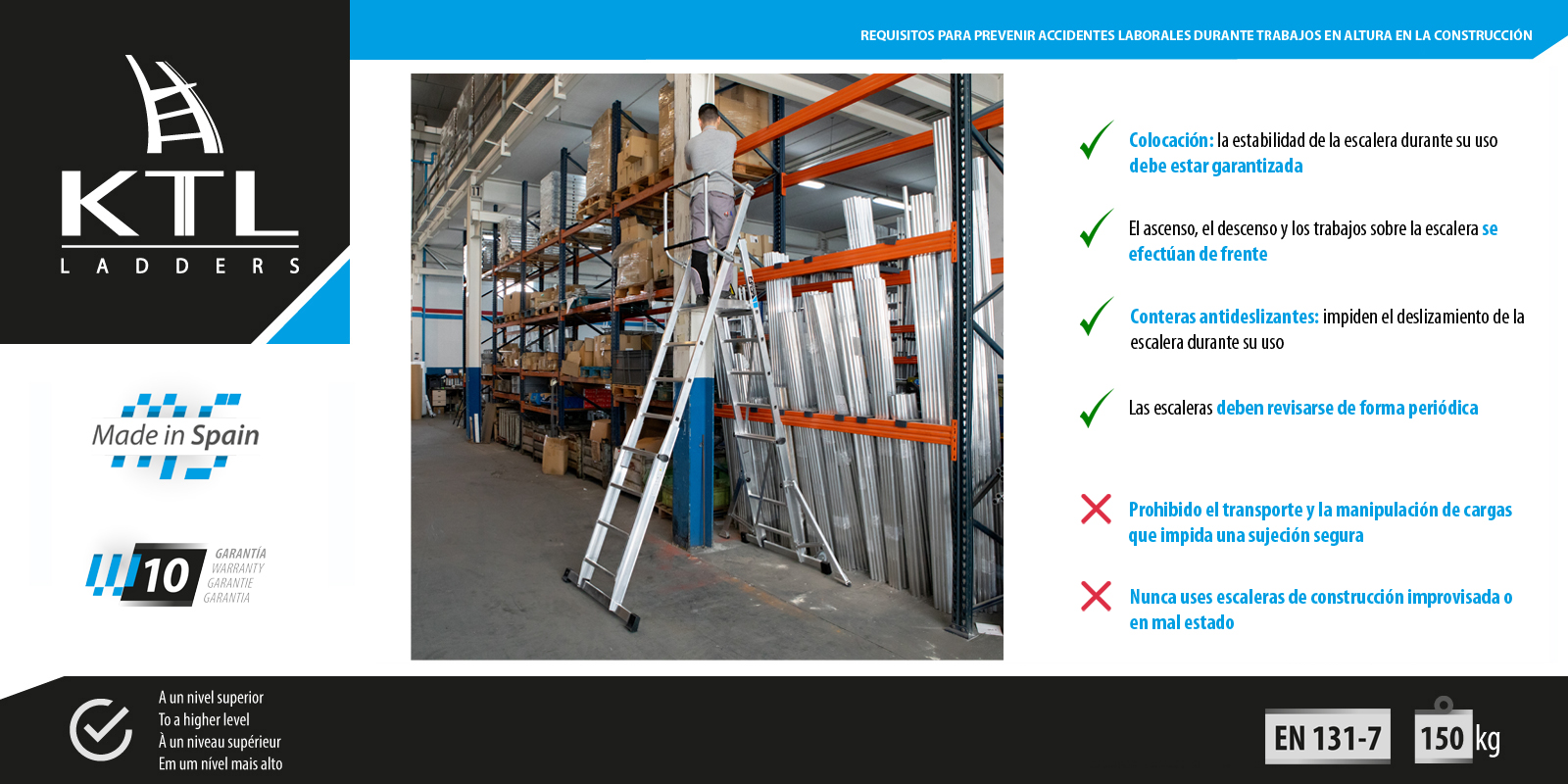Ladders are essential tools used by professionals in logistics, construction, or masonry to perform tasks at height comfortably and safely. However, stress, the need to finish a task quickly to improve productivity, or overconfidence from performing the same task continuously and mechanically can sometimes lead professionals to overlook the risks associated with the improper use of ladders. Unfortunately, the media frequently reports on work accidents involving ladders that could be avoided if all workers received proper Occupational Safety and Health training.
Work accidents are a significant issue, claiming many lives each year. According to the ‘Work Accident Statistics’ (EAT) report by the Ministry of Labour, in 2022, there were 679 fatal accidents during work hours, 25% of which were related to falls involving ladders –whether during climbing, descending, or using tools while working at height-.
At this point, companies play a crucial role, as their Occupational Safety and Health departments are responsible for ensuring worker safety. They need to inform employees about the risks of poor practices, provide precise instructions for safe task execution, and schedule initial and periodic training to ensure all protocols are being followed.
One common mistake by workers is using ladders instead of other, possibly safer or lower-risk equipment. When choosing a ladder, consider your specific needs for the task at height. Questions to ask include the frequency of use, the height to be reached, and the type of use, among others.
Types of ladders
A ladder for every need. Often, professionals use the same ladder for various tasks without proper planning, making human factors crucial in ladder-related accidents. At KTL-Ladders, we offer top-level height solutions. We have prepared a list of the most commonly used types of ladders and the recommended situations for their use.
- Single ladders: This model, with only one section, is not stable on its own and requires a surface to lean against for support and professional ascent. Single ladders are used by leaning them from the ground against a wall and can also serve as access ladders to reach rooftops or different levels in buildings or industrial and commercial facilities like machinery or computer systems. At KTL-Ladders, we offer the fixed ladder and the wide-step fixed ladder from the industrial series, providing maximum comfort and safety for your work at height.
- Stepladders: This ladder, having two sections that open in opposite directions, is stable on its own, allowing the user to perform tasks comfortably, safely, and stably. Stepladders are commonly used by professionals who need to perform temporary work at intermediate heights, making them frequent in sectors like gardening, carpentry, maintenance, or roof and wall repairs. They are also suitable for tasks requiring a lot of mobility and regular access, providing stability to carry out tasks efficiently and safely. At KTL-Ladders, we offer a wide range of stepladders –including models with platforms, double access, telescopic, etc.– noted for being foldable and easy to transport.
- Extension ladders: This model consists of two or more simple ladders stacked and joined by guides or hinges. This type of ladder allows professionals to reach high work heights with maximum comfort, safety, and stability, making them widely used in activities related to masonry, carpentry, or industrial installations. At KTL-Ladders, we offer both manual and mechanical extension ladders, which feature a mechanical sliding system with a rope for easy, quick, and comfortable length adjustment. KTL-Ladders models include sliding wheels on the upper section, facilitating easy extension of the ladder.
- Combination ladders: This type of ladder allows professionals to work at various height levels comfortably, safely, and stably. Commonly used in construction, masonry, or service sectors, these ladders are known for their great versatility, adapting to nearly any situation. Combination ladders are durable and robust and can be used in either support or stepladder position depending on the task or height. At KTL-Ladders, we offer two and three section ladders equipped with an aluminium safety lock to prevent accidental opening or unintentional movement of the upper section during use. Additionally, our industrial series models include wheels to facilitate movement along walls or facades.
Mistakes in using ladders
The Occupational Risk Prevention Service of companies must be responsible for assessing the risks of ladder use and implementing appropriate preventive measures. They must train and inform all workers about the dangers of improper use, as any error, no matter how small, can lead to serious accidents. From KTL-Ladders, we have identified five common mistakes made by professionals during their work at height:
- Not maintaining three points of contact. To ensure proper ladder use, the user must maintain three points of contact at all times –for example, two feet and one hand– to guarantee maximum safety. Thus, ascents and descents should be made without carrying any load.
- Placing the ladder on unstable surfaces. The base or feet of the ladder should be placed on a stable, solid, and level surface. Placing the ladder on unstable surfaces –such as tables, chairs, scaffolding, or boxes– or on slippery surfaces –like freshly painted walls or glass areas– is considered inappropriate.
- Loss of stability: Incorrect positioning, inappropriate angle on single ladders, or incomplete opening on stepladders; not checking the condition of elements -feet or non-slip pads, side rails, steps, etc-; not activating safety lock mechanisms; or not locking wheels to prevent accidental movement are some faults that can lead to falls.
- Excessive confidence. The environment or low work height can lead to overconfidence, causing the use of inappropriate ladders, which can result in serious consequences. Sometimes, work at height is performed by untrained or inadequately qualified individuals.
- Performing unstable tasks Ensuring stability during work at height is crucial. Therefore, avoid exceeding reach, keep your waist between the side rails, and both feet on the same rung to prevent accidental ladder movements that could cause falls.
Preventive measures in ladder use
Professionals using ladders must take precautions during use, placement, and transport. Before starting work at height, consider factors such as selecting the right ladder for your needs, understanding the support surface characteristics, and checking for additional risks such as electrical contacts. Many ladder-related accidents are preventable, making it crucial to implement appropriate preventive measures to safeguard health.
Before use
- Check for damage. Ensure that steps are in optimal condition –not loose, poorly assembled, broken, or cracked– and verify that support and attachment systems are in good condition without defects in auxiliary elements –pulleys or ropes-.
- Remove any substances from the steps, rungs, or side rails that could cause loss of balance and stability –such as grease, oil, mud, or wet paint-.
- Ensure that locking systems are fully engaged. For stepladders, the rope, tensioner, or safety strap should be fully extended to prevent accidental opening.
Ladder placement
- The ladder must rest on a flat, horizontal, non-slip, and sturdy surface. To avoid accidents, the ladder should be placed on its own feet and never on movable or unstable surfaces like chairs, tables, boxes, or bricks.
- Ladders used for access to upper floors should extend at least one meter above the work plane.
- The area around the ladder base must be clear of materials and away from moving elements that could knock it over. If placed near doors or pedestrian areas, it must be properly marked.
During use
- Ascents and descents should always be made facing the ladder, maintaining three points of contact. During work at height, keep your waist between the side rails and avoid extending beyond reach.
- The ladder can be moved from one place to another as needed, but never while someone is working on it. Additionally, it is prohibited for two or more people to use the ladder simultaneously.
- On double access stepladders, avoid working straddling or moving from one side to another across the top. For support ladders, standing above the third rung from the top support point is prohibited.
After use
- Once work at height is completed, clean the ladder to remove any substances that may have fallen on it.
- Ladders should be stored horizontally, secured to fixed supports, and protected from weather conditions that could damage their structure.
At KTL-Ladders, we provide the Occupational Risk Prevention sector for companies, factories, and industries with height solutions at a higher level, offering professionals maximum safety in their storage or maintenance tasks. Our models feature safety locking systems to prevent work accidents, comply with the safety requirements established by relevant European Standards, meet the highest certified quality demands, and are specifically designed for professional and/or industrial use.




